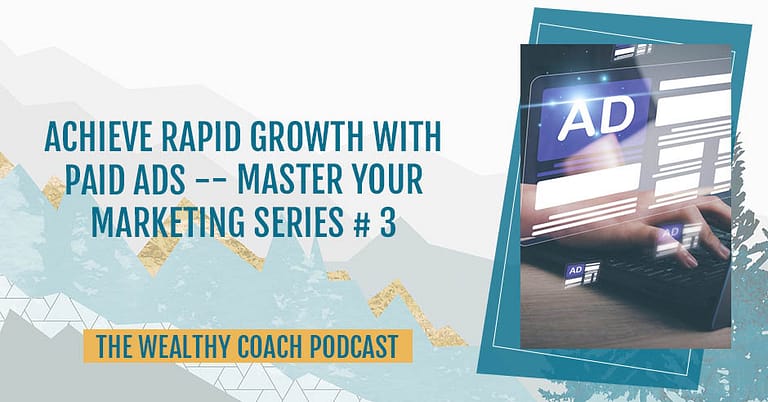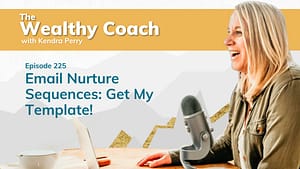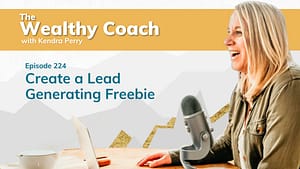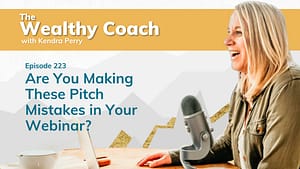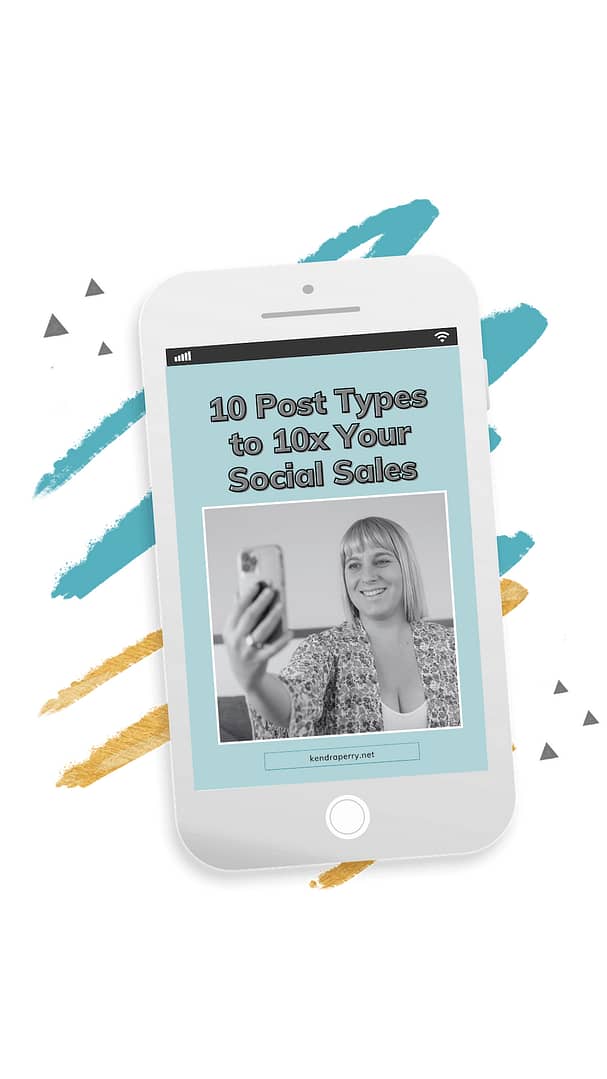In this third episode of the Master Your Marketing Series, Kendra Perry focuses the conversation on paid ads and how to execute them the right way. This is an integral part of every business that wants to build a strong online presence while navigating the vast ocean of content creators. Kendra talks about her shift to paid marketing because of the COVID-19 pandemic and the four components of a high-converting advertisement. She also discusses the anatomy of a good copy, how to use free resources to reconnect with an already warm audience, and the things to consider when running paid ads alongside the ever-changing Facebook algorithms.
Apply to work with Kendra inside her 6-month Mastermind Program: https://kendraperry.net/apply
—
Listen to the podcast here
Achieve Rapid Growth With Paid Ads — Master Your Marketing Series # 3
Welcome to Episode 3 of the Master Your Marketing Series. We’re going to be talking about paid marketing. If you haven’t tuned in to the 1st and 2nd episodes in this series, scroll back on the feed for this show and give those a tune-in because all of these episodes do build on each other. In order to be successful with paid marketing, you need to go back and tune in to episodes 1 and 2 where we talked about messaging and also organic marketing. A lot of people might be wondering what does organic marketing have to do with paid marketing. I discussed this a little bit in the second episode, but they do need to align.
Even if you’re doing paid ads, you still need to be posting organic social media content. This is because people are always going to check you out on social media. I notice this in my behavior all the time. I’ll see an ad and I’ll be like, “That’s interesting.” I won’t click on the ad. I’ll click over to their profile and I’ll check them out. If the content doesn’t align, or they haven’t posted in a while, or the content’s not very good, then I probably won’t click into their ad because I’m like, “Not sure about this person.” The organic content does help you establish your credibility, expertise, and legitness. I don’t know if that’s a word, but we’re going to use it.
I am someone who has primarily focused on organic marketing in my own business. Up until the past few years in my health coaching business, I was almost all organic marketing with the exception of the few times I did dabble in paid ads. I am someone who has been a big proponent of teaching organic marketing. I still teach organic marketing, but I’ve made a shift in the past year, and I’ve brought in paid Meta ads, Meta being the company that owns both Facebook and Instagram.
I’ve made a bit of a shift over in 2022. In HCA, my online program, we’ve brought in paid ads to my most recent update. Why did I make this shift? It’s because HCA has been around for about four years, and it’s always focused on organic marketing only. Some of my messaging has been around how to build a six-figure business without paid ads. I’ve helped many students do that. What I’ve noticed is that the landscape has changed. A big part of this changing landscape is what happened with COVID, which forced the shutdown of so many businesses causing a ton of businesses to flood online. What COVID did is help people recognize the beauty of the online world, having an online business, having a freedom location, and the ability to make a lot of money.
I figured people would figure that out at some point. I was like, “People are going to eventually realize this.” When I started in 2013, it was a very different landscape. Much less competitive. It was much easier to grow on social media, build a business, and make money. It’s different now because now we’re dealing with a lot more competition. We’re also dealing with the phenomenon of the content creator. These are people who make money by creating content. They build big followings. They get brand deals. They might have like a merch line or something like that.
Essentially, they are not like you, meaning that they’re not working with clients. Their job is to create content and build a following. You can’t be creating content all the time because you’re a clinician, you’re a practitioner, you’re a coach, you’re working with clients, and you can’t be creating content all the time. You also might not be the best at creating content because we’re not content creators. I’m decent at content, but I cannot compare with a content creator who has all day to create content. I have other things to do in my business.
Not only are you competing with more business owners on social media, but you’re competing with content creators who are very naturally creative and also have a lot of time to be creative with their social media. I have seen now how increasingly hard it’s become. I’ve seen that in my students, especially over in 2022, where things are happening slowly. They’re working hard and they’re doing all the right things, but they’re not getting the traction that my students used to get in 2019, 2020, and even 2021.
Paid Social Media Ads
That made me recognize that it’s time to bring paid ads into my program. I was very excited to do that because my goal is to get my students the best results. I don’t care if I’ve built my messaging over how to build a six-figure business without paid ads. If I see a shift in the market and if I see that I could bring that in and it’s going to help my clients get better results, then of course, I’m going to bring it in. With social media, while it is important, we do want to be posting on social media and while it’s still very possible to grow organically, people do it. I have students who do it all the time. If you want to grow faster, then this is the way to go.
When we think about social media, maybe 2% of the people who are following us see our content. We don’t want to be relying solely on social media. This is why in Episode 2 of this series, I talked about growing an email list and the value of that. We can’t grow an email list out of thin air. We have to push people to an email list through our organic channels, but we can also do that through our paid. With organic marketing, we talked about collaborations, things like being a guest on someone’s podcast or guest blogging. We talked about social media and how to utilize that. We also talked about search engine optimization to push people to an email list.
When we’re using social media alone, and sometimes even collaborations alone to grow an email list, sometimes it takes time. Something I know about people who are in their early stage or even mid-stage, there is a lot of impatience. You might be early stage or you might even be higher level. In both ways, we can feel impatient and we might want to grow faster. Some of my clients whom I helped build their businesses in 2019 and 2020, have grown primarily organic, but they’ve reached out to me and they’re saying, “I’m finding it a lot harder. Is there any way I can hack the Instagram algorithm?”
For the most part, we can’t hack the algorithm. It’s always changing, especially when we’re talking about Instagram. It changes so much. I can’t keep up. There are always updates. There are always new features. Reels are the hottest thing. Suddenly, they’re not. Now, it’s Carousels. Back to Reels. Now, we’re at photos again. It’s all over the place. My suggestion for a lot of these people is to start investing in ads. There are lots of different ads that you can invest in. There are Meta ads, which are Facebook and Instagram ads. I might refer to those as Facebook ads in the rest of this episode. When I say Facebook ads, I’m speaking of both Facebook and Instagram ads. There are YouTube Ads, Google Ads, and ads for other social media platforms like TikTok, Pinterest, LinkedIn, etc.
My favorite is Facebook Ads because I believe they are still the most inexpensive, they are the easiest to make, and they have the best user experience. The thing I love about Facebook Ads is they blend in with the feed. Yes, there’s always going to be a little tag called “sponsored” below it. because Facebook likes to be transparent, so you’ll always know that it’s a sponsored post, but it blends in with the feed. I like that because ads on other platforms aren’t like that.
For example, on Google, you know when you’re seeing an ad. It’s very obvious when you’re seeing a Google Ad either embedded in a blog post you’re reading or at the top of the search. With YouTube, you know it’s an ad. You try to skip through it. I very rarely engage with YouTube Ads. I’m usually actually skipping through it after the five seconds. Also, you can imagine that you have to be pretty good at video. There has to be some good production when it comes to making good YouTube Ads. On other social media platforms like TikTok, Pinterest, and LinkedIn, you can run ads. You can probably be successful with them, but we are dealing with platforms that have fewer users and also platforms that have less user data.
Meta or Facebook has been around since 2005. They’ve collected a ton of user data. That’s why when you go on Facebook, you can think about something and suddenly you’re being shown those ads because they’re very good at figuring out what your interests are. It’s easier to find your people using Meta and Facebook Ads. I still do believe they are the most inexpensive.
We talked about messaging in Episode 1. Hopefully, you can remember the customer exercise. That’s where we started to nail down our target audience messaging. We started to get to know the person of whom we are targeting. Hopefully, you can remember as a part of that, there was an Ecosystem, which is the E part of the CUSTOMER acronym. The ecosystem is essentially where your person hangs out online. This is so important to understand when it comes to creating audiences for whom you are going to target your ads. We don’t want to throw our ads out into the abyss and hope that the right people find them. We want to intentionally create audiences of people to whom we could run those ads. That relies on us knowing who our people are and their interests on Facebook and Instagram.
For example, we want to know what books your person reads because we could target authors of those books. We would want to know where that person shops because if we knew where they shopped, we could potentially target them. For example, if we’re targeting new moms who have postpartum depression, maybe we’d be targeting companies like Huggies, or maybe we’d be targeting companies that make baby toys or baby clothes, or maybe we’d be targeting books about being moms. We’re not always targeting postpartum. We’re trying to find where that person is online and what interests they have.
High-converting Ad
It’s important to understand who your person is in regards to their interests, where they hang out online, what podcasts they listen to, what magazines they read, etc. We also want to know them so that we can write high-converting ad copy. When we’re talking about the components of a high-converting ad, there are four components. There is the hook, the copy, the creative, and the headline. The hook is the first line of the copy and it’s called a hook because it’s meant to hook the person and get them to read the rest of the copy.
A hook is important in terms of your organic content as well. One of the original and top copywriters in the world who came up with the concept of direct-response advertising is David Ogilvy. Essentially, direct response advertising is writing in a way and advertising in a way to make someone take a specific action at that moment. He said that 80% of your effort should go into the hook of your content, because if the person doesn’t get hooked in by the hook and they don’t read the rest of the copy, then all your writing has gone to waste. This is important in Facebook Ads. We have the hook.

We then have the copy. That’s the rest of the text. That is attached to the ad, which essentially is going to advertise the thing that you want the person to do when they interact with the ad. There’s the creative. This is going to be the image or the video that is attached to the ad. This could be something like a static graphic. It could be an image of you. It could be an image of you with some text on it. It could be a carousel where people are swiping through the slides. It could be some video. We then have the headline. On a Facebook or Instagram Ad, this is lower down, it is below the image but it describes what the person is going to get when they interact with the ad.
Copy
The first thing I want to talk a little bit about is copy because the copy is technically the harder thing to write when it comes to your ads. It’s the harder part about the ads because the copy has to be on point. The creative or the image of the video is what will grab the attention of the ad, but the copy has to be on point or the person is not going to click through and take action. I’m going to give you something incredibly valuable, so grab out your notes and a pen, and write this down because I’m going to give you a very simple ad copy script. This is something that I give my students inside the Health Coach Accelerator.
The first part of the copy is the hook. I separate this, but I want to reiterate the importance of the hook. That’s something that is going to grab the audience’s attention and it gets them to keep reading. It could be a shocking statistic, it could be a question, it could be a statement, or it could be an audience call out. As an example, I could say something like, “Attention, ladies in their 40s struggling to lose extra pounds that won’t budge,” because maybe I’m giving away a weight loss guide and I am calling attention. The hook should call attention to your target audience. It should be very specific. It shouldn’t be generic because you want to make sure you are specifically calling out your target audience.
The next part of the copy script is something I call the pain point question. This is where we want to engage the reader by asking them a question that speaks to the primary pain point that the offer is going to help them solve. You could say something like, “Sick and tired of exercising and dieting until the cows come home, yet still not seeing any results on the scale?” I’m using this weight loss example. We want to speak to a pain point. If you don’t remember what that is, go back to Episode 1 of this series where we talked about messaging and where we talked about what pain points were.
The next thing is authority. This is where you want to share something about yourself to establish your authority and show them that you are someone they can trust. It might be your credentials or your years of experience. It could be how many clients that you’ve helped. You could say something like, “I’m Jenny. I’m a certified health coach with over five years of experience. I’ve seen client after client struggle to get their weight in check despite doing all the right things. They eat healthy, they exercise, yet they are still dealing with pounds that won’t budge.” What I did there was introduce myself. It was Jenny. I said my credentials. I said, I’ve got over five years of experience and I’m speaking to, “I’ve seen so many clients and I’ve seen this over and over.” What that is doing is it’s establishing my expertise.
Next is the offer. This is where you tell them about the offer in the ad. We are not running ads to build your social media. That is not a good use of your money. We are always building ads, for the most part, to grow our email list. We want to grow our email list. Once they’re on our email list, we’re going to sell them. The best thing you can do for an ad is give away a free offer or a free resource. This could be a guide, a checklist, a webinar, or a video series. There are all kinds of things we can do.
The next thing we’re going to want to do is tell them what that offer is, why we created it, and how it helps them solve that pain point that you spoke to earlier on in the copy. I could say something like, “That’s why I created my exclusive over 40 weight loss guides so that women can stop spinning their wheels, start seeing real results with their weight, rock that new bikini, and feel confident in their favorite jeans.” I’m introducing the offer and I’m telling them what it does and how it’s going to help them solve the pain point.
The next thing you can do is list out all the amazing things that they get when they download this freebie, download the video, or register for the training. You’ll go point by point and you’re going to show them everything that they’re going to get. The intention here is to show them that it’s pretty awesome and they’re getting it for free.
Next, we’re going to seed in some urgency. We want to tell them that the offer is limited and it won’t last forever. We’re then going to seed in a desire question. We want to ask them a question that speaks to the outcome that the offer is going to help them achieve. You could say something like, “Ready to rock that dream body and rock that little black dress on date night?” I’m speaking to the outcome that they want. They want to have their dream body. They want to fit into that little black dress.
The final thing is the call to action with the link. You’re going to tell them to download, to register, to click through, and you’re going to add the link to your opt-in page. We’re going to send them to a third-party page where they can access and download the freebie. There’s going to be that little form. They’re going to input their first name and their email address. When they do that, that information’s going to get sent over to your email list, and then they’re going to get an email that delivers the free resource.
This is just an example of a script that works well. It’s very simple. It relies on you understanding your person and how to speak to them, what they want, their desires, their pain points, what’s going to connect with them, and what type of resource they might want. What I’m going to say with copy is you do want to make sure that your copy always complies with the Facebook advertising guidelines.
These are always changing. They’re always being updated and you do want to comply with them because if you don’t, your ad won’t get approved. This is especially true in the weight loss space. I gave you a weight loss example. This is an ad that I’ve seen get approved. What I will say is it’s a little bit on the line. You might have to tweak it slightly. Just know that.
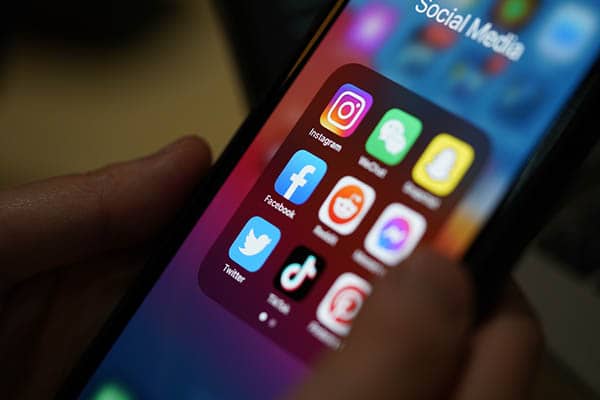
The other thing I want you to know in terms of creative which we’re going to dive into in a second, is you can’t use before and after photos. If you’re in the weight loss space, you cannot use an image that is a before and after image because Facebook does not allow that. Something very cool that you can do is you can use the script that I gave you. You can copy it over into ChatGPT, give ChatGPT a little bit of information about your audience and your offer, and ChatGPT can write the copy for you. This is something I also show my students how to do. Ad copy can be tricky and we have this amazing tool called ChatGPT where AI will help you write your copy.
Next, I want to talk about what creatives perform best in the health, wellness, and personal development industries. The answer is annoying. It depends. Truthfully, what works for one coach won’t necessarily work for another. You may hear ads experts saying, “Video ads. You need to use video.” That may not necessarily work for you. I found that video is less effective for my audience.
My audience tends to like Carousels and static images even though I’m great at video. You’ll have to test it and see what works for you. Once you find a creative that works well for you where you’re getting a good cost per lead and you’re growing your email list. Maybe it’s a Carousel post. That means if you decide to do different ads in the future, I would always start with using a Carousel post because that’s been proven to work for your audience.
Free Resource
My favorite strategy for paid ads is a warm audience retargeting strategy. It’s an old-school strategy that a lot of people don’t do anymore, but I still think is amazing and helps your ads be cheaper. What we’re going to do is create a warm audience, and then retarget them with the free resource. What do I mean by a warm audience? If you tuned into Episode 2 of the series, I talked a little bit about the difference between cold, warm, and hot leads in regards to organic content. It’s also true for paid ads. People who generally find you through ads are cold and they’re super cold like ice cold. It’s because they don’t know you at all and they’re probably skeptical. We can warm them up in advance before we deliver them a free resource.
We can do that by running a brand awareness ad. The cheapest way to do this is through a video views campaign where you’re optimizing for through plays, which is where Facebook is finding you people who are going to watch at least fifteen seconds of a video. What you’d want to do is take a video that is very specific to your target audience. This could be a reel that you did that performed well. This could be maybe a YouTube video that you did or maybe you on a video podcast. You want it to be relatively short, generally under about 2 to 3 minutes, and you are going to optimize.
What I mean for that, being by that is when you set up your ads, the first thing in Ads Manager. We’re doing this through Ads Manager. We’re not doing this through a boosted post. You need to learn how to set up your ads dashboard. There are YouTube tutorials for that. Essentially, the first thing you’re going to do is you’re going to go create a campaign and it’s going to ask you what you want to do. I believe you’re going to look for engagement and then video views. The reason why I recommend video views is because video views are very cheap. You can get a through play for about a penny, sometimes less. I have a video views campaign where I’m spending 1/3 of $0.01 or something like that per view.
You can have a very cheap budget. You can spend $5 to $10 a day. What this does is it starts to build a warm audience because Facebook is going to collect all those people within this video views. Over time, that audience is going to get bigger and bigger. You then can do a lead magnet campaign where you optimize for leads in the campaign objective. You’re going to choose leads and you are going to target your lead magnet ads to that warm audience.
Something you can also do is add in other warm audiences because, within your audience tab in Ads Manager, there is something called audiences and then custom audiences. There will be an option to create a custom audience. If you have a website, you can place a Facebook pixel on your website, which is essentially a piece of tracking code that will keep track of everyone who lands on your website.
Maybe you’re a blogger or you have a podcast and you get a decent amount of website traffic. You should pixel your website so that Facebook can keep track of everyone who lands on your website. You can also create an audience for people who engage with your Facebook or Instagram content. You can add your Instagram followers and your Facebook followers to those audiences.
What you can do essentially is create this entire warm audience. These are people who aren’t seeing you for the first time. They follow you on Instagram or Facebook. They’ve engaged with your content and they’re going to be way more likely to want to click through a lead magnet ad and download that resource. This can make your ads a whole lot cheaper because when you run your ads to cold traffic, there are people who don’t know, like, or trust you. Typically, you’re going to be spending a lot more. It is very easy to set up a video views campaign. You can find out how to do this online or you can come into Health Coach Accelerator and we can show you how to do it. Essentially, you can start building your warm audiences.
A cool thing about doing this is when you run a video views campaign, you tend to get more followers because there is more reach and visibility on your profile. You get to kill two birds with one stone. You get to build these warm audiences that you can retarget later. You also tend to grow your social media following. What this will do over time is give you this massive warm audience that you can advertise to so that when you’re launching, you’re not launching to cold people. You are launching to people who are already warmed up.
Interest-Based And Broad Targeting
There are a few other types of audiences that you should target. We always want to be targeting our warm audiences. This is good and you’re probably going to be doing that at a bit of a lower budget because it will be a smaller audience size. If you want to get bigger audiences, we can do interest-based audiences or broad targeting. Interest-based audiences are creating audiences based on what people are interested in.
For example, I mentioned this at the beginning, you could figure out, you could go ask ChatGPT, “What are the top books that my target audience is reading?” If we’re using the moms with postpartum depression, you could say, “What are the top books that new moms are reading?” You could also go in there and say, “What are the top companies that my people are buying from? What are the products that they’re buying from?”
You don’t want to mix interest audiences. If you’re doing books, I would do books. Essentially, you can go into Facebook, go into audiences, create a custom audience, and do it based on interest. You can search Facebook and see if those interests are available. Maybe you would come up with 25 different authors that your people might follow or read books from, and then you go into Facebook and see which ones are targetable.
The annoying thing about Facebook that has always driven me crazy is not everything is targetable. Even if a company has a business page on Facebook, it doesn’t necessarily mean you can target it and they’re always changing what you can target. Sometimes they take things away. It’s super annoying. If you come up with 25 different authors that your person might engage with, then you could potentially find 5 or 6 those to target.
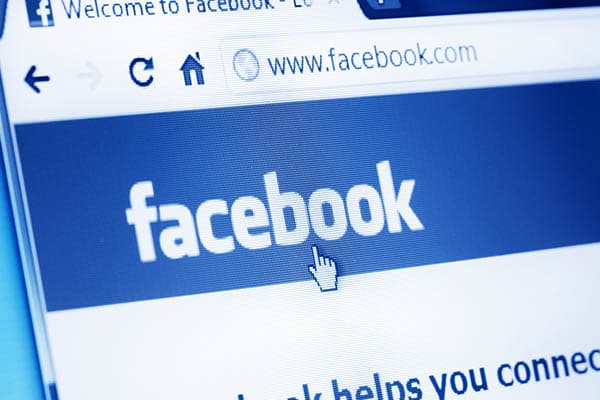
We’re trying to get at least 500,000 people in an audience. If not, 1 million is better. If you only have 10,000 people based on books, then I probably wouldn’t use that audience. You can set up interest-based audiences. Finally, you can do broad targeting. This is a better strategy once you’ve been running ads for a while and your pixel has some information.
Broad targeting essentially is where you narrow down your audience based on age, gender, and location. That’s it. The copy and creativity of your ad are what finds the audience. This is something that’s become more popular in recent months and maybe in 2022 because the Facebook AI tool for figuring out who to target has become increasingly smart or intelligent, but it’s not great if you are brand new and you have no information on your pixel.
If you’ve been running ads for a little bit of time, it’s something you can test. This is the strategy that I teach my students inside HCA. What we do is have them create 1 piece of copy, 2 different versions of creative, 1 hook, and 1 headline. When you are testing, you only want to be testing one variable at a time. Think about the scientific method. We don’t test multiple variables at a time because then if something shifts, we don’t know what shifted it.
If you have a budget of under $50 a day, you’re going to do two audiences. I recommend two interest-based audiences. If you’ve been running ads for a while, you can do an interest base and a broad targeting. For each ad set or audience, you are going to do the copy with each version of the creative. In each ad set, which is the audience level, you are going to have two different ads. That is what you’re going to set up and you’re going to see how they perform.
I don’t recommend making any decisions about ads until at least 3 days have passed and at least 1,000 impressions are on that ad. If something is underperforming, meaning that you’re paying too much per lead, then you can turn it off. I want you to be realistic with what you are paying per lead. When I say that, I mean the amount you are paying for each person that joins your email list.
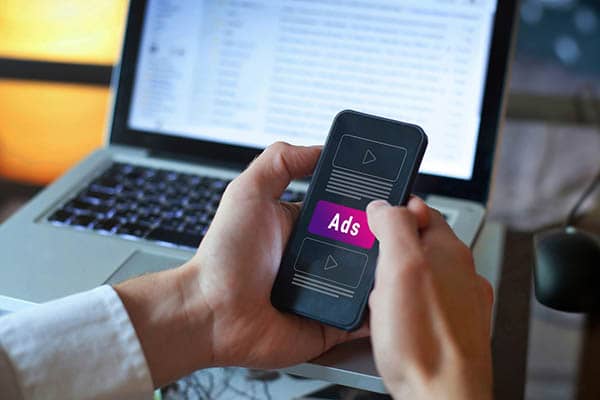
In health and wellness, you can advertise for a lot cheaper than in other industries, but the average cost per lead is about $2 to $10. Anywhere within that range would be considered an industry average. If you’re paying $15 or $20 a lead, then you may want to switch up the creative and test new creatives. If that doesn’t work, you might start testing different copy versions. If you’re in that $2 to $10 range, that’s good. If you’re below $2, you’re crushing it.
We don’t want to run people or drive people to our email list and then do nothing with them. I talked a little bit about nurturing in Episode 2 of this series, so go back there. We want people to get access to an email nurture sequence where they automatically receive an email each day that warms them up, nurtures them, and introduces them to you and what you do.
Long-Form Content
I also find it effective when we are filling our list with people from ads to push them to some form of long-form content. It’s going to be best if this is some video or audio content. For example, you could send them to Instagram Lives that you’ve done or Facebook Lives. If you have a podcast, I would drive them to your podcast because we want them to have a little bit more of an intimate experience with you. If they’re just reading text, it’s going to take a lot longer for them to warm up to you. In your nurture sequence, I do recommend pushing them to your long-form content.
Something to know about paid ads. People from paid ads sometimes take longer to buy than people who come to your list from your warm audiences like Instagram or Facebook. That’s why when I run ads, I push people to my show. For example, I’m going to push a lot of people from my list and also, I’m going to use this show series to warm up those people on my list and to create another warm audience. This show series is a great way to warm up colder people in my audience.
Running Your Own Ads
Can you run your ads? Yes. I have been running my ads for the past year. It’s not that hard. It’s pretty simple. I’m not going to say it’s easy. If you don’t know what you’re doing, I highly recommend taking a course like coming into Health Coach Accelerator or getting some coach who’s going to help you with it because otherwise you could waste a lot of money and make a lot of mistakes. You can also hire an ads manager, but I don’t recommend hiring an ads manager until you’re spending upwards of $75 a day. If you’re spending less than $75 a day, you can run your ads. It’s very learnable.
Funny enough, I learned how to run ads in either 2015 or 2016, and then I didn’t run ads for a very long time. When I came back to them, it was the same. The ads dashboard was the same. There were a few changes, but it didn’t take me that long to pick back up. What I’m saying is that you can learn it once and then you will be good.
Final Words
How does this fit in with Episodes 1 and 2? Messaging is important for paid ads because if we don’t have good messaging if we don’t understand our target audience, and if we can’t write good copy, then we are going to struggle with ads. I’ve talked about how organic traffic fits in there because people are always going to check you out. When they see your ads, they’re going to click over and look at your profile. How this fits into Episode 4 where we talk about live launching is that what ads can do is help you build your email list in advance of a live launch so that your marketing with your live launch goes a whole lot easier, and then it makes selling a whole lot easier.
New Program For Higher Level Coaches
I want to tell you about something very exciting. I have a coming up in January 2024 that I have never done before. I’m going to be running a six-month mini mastermind for higher-level coaches, practitioners, and professionals. If you are in the health and wellness space or personal development space, if you coach practitioner, professional, or healer, and you’re generating at least $5,000 a month in your business and you want to grow to multiple six figures and beyond, then this program is going to be exactly what you need. This is going to be a very customized program where I help you with what you need based on your goals and your business situation.
What I teach in this program is going to be very specific to the people who ultimately join. It is going to be a combination of community, group coaching, and even one-on-one coaching, which is not something I have offered since 2019. I’m going to audit your entire business and we are going to come up with a strategy for you to execute over the next six months. You then will get coaching and support from me to achieve your goals. I have special founding member pricing for the first five people to sign up. I believe we have a couple of spots left at this point. That will be available until November 15th, 2023 and then the price will increase.
If that sounds like you, if you are a coach, practitioner, professional, or healer who is making at least $5,000 a month and you want to grow to multiple six figures and beyond in 2024, then I invite you to apply by going to KendraPerry.net/Apply. You can also shoot me a message on Instagram, @KendraPerryInc, and let me know you’re interested, we can have a chat, and see if it feels like a mutual good fit. I hope you enjoyed Episode 3 of the Master Your Marketing Series. Next, we are going into Episode 4 where we are going to talk about another one of my favorite topics, which is live launching. I will talk to you then.
Important Links

